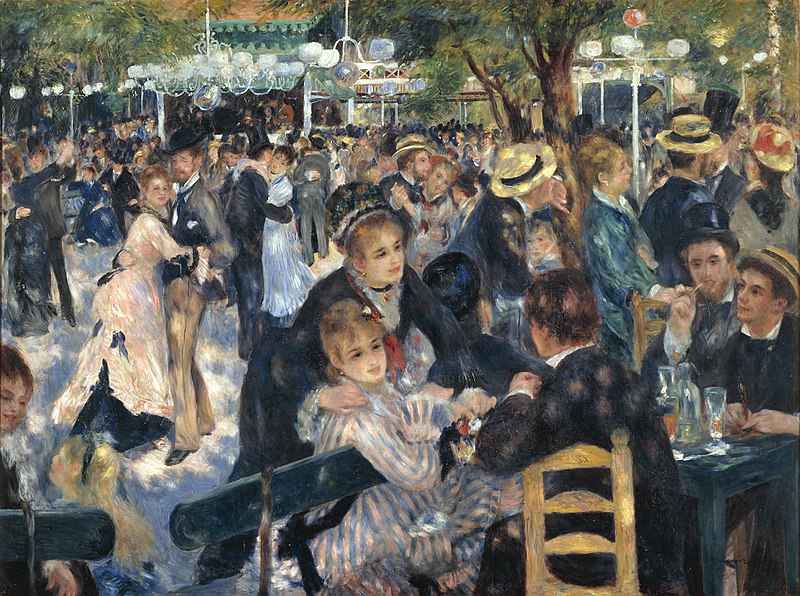Although fields and country scenes are usually linked to Impressionism, most French Impressionist painters got their careers started off in urban Paris. As such, there are a number of places connected to the artists of this 19th-century art movement in and around the capital. After you’ve seen their works in the museums of Paris (suggestions at the end), head out onto the streets of Paris to see where the Impressionists painted.

Quai du Louvre, Claude Monet (1867)
The Seine River
The city’s iconic river appears in the works of the Impressionists, both inside and outside of Paris. Their love of the Seine might have been sparked in the early days of a small group of these artists, Monet, Sisley, Renoir and Bazille, who met in the studio of Charles Gleyre. It was located on the Right Bank of the river near on Quai du Louvre, in between Pont Neuf (more on this below) and the Pont des Arts, which was yet to be built.
Over the course of the next thirty years these artist commemorated the Seine dozens of times, often from one of the guinguette dance halls which once dotted the river in the city’s western suburbs, like on the Ile de la Grande Jatte or the Ile de Chatou. You can trace the path of their paintbrushes on Chatou’s Chemin des Impressionistes walking route.

The Pont-Neuf, Wreck of Bonne Mère, Camille Pissarro (1901)
The Pont Neuf
Perhaps due to its location near Gleyre’s studio, Paris’s oldest bridge became a recurrent subject matter of the Impressionists. Renoir, Monet and Pissarro all immortalised the bridge, the latter of whom painted it several times (including the top image), as was common with the Impressionists.

The Tuileries (Study), Claude Monet (1876)
The Tuileries Gardens
Also near Gleyre’s studio, the Impressionists might have also appreciated this beautiful historic garden for its natural qualities. Easier to get to than the Normand countryside, the park was a popular place at the time for gatherings, as seen in pre-Impressionist Edouard Manet’s Music in the Tuileries Gardens. Monet, Study of the Tuileries. Monet was fond of the park and painted it from various angles, like the above study of the gardens.

Le Pont de l’Europe, Gare Saint-Lazare, Claude Monet (1877)
Le Gare Saint-Lazare
Even though the Impressionists were more interested in nature, the technological advancements of the 19th century did occasionally appear in their art, including Paris’s first train station. Le Gare Saint-Lazare was also the station from where the Impressionists could access Normandy. The station was captured on several of Monet’s canvases. He explored different perspectives, from the interior as well as from the train bridge behind the station, le Pont de l’Europe, the locomotives billowing smoke creating a very impressionist effect.

Le Bal du Moulin de la Galette, Pierre-Auguste Renoir
Montmartre
Initially drawn to Montmartre in order to work on one of his most famous paintings, Renoir was likely the biggest fan of Montmartre of the Impressionists. He spent the summer of 1876 in this then very working class former village as he worked on Le Bal du Moulin de la Galette. The space he used as a studio and its gardens, where he painted The Swing, are now part of the Musée de Montmartre. From that moment until the early 20th century, Renoir lived and worked in Montmartre. Although the nearby cafés of Montmartre are rather touristy now, places like Le Consulat and La Bonne Franquette, were frequented by the Impressionists. Post-Impressionist artist Vincent van Gogh lived in Montmartre from 1886-88 and painted a number of scenes in the hilly district, included around a dozen paintings of the area’s moulin, its windmills, two of which still stand on rue Lepic, the same street the artist lived on (at #54)

Musee Marmottan Monet
Where to See Impressionist Art in Paris
Several Paris museums have important collections of Impressionist art. The most famous of these is the Musée d’Orsay, however, the Orangerie, the Musée Marmottan Monet and the Petit Palais museum also have wonderful collections and several of the works included above!
If you would like to delve deeper into the art of the late 19th and early 20th centuries, consider pursuing our Master’s in the History and Philosophy of Art. Learn more about it, and our other MA programmes in film, creative writing and Medieval studies, at this link.
Top Image: Morning, Winter Sunshine, Frost, the Pont-Neuf, the Seine, the Louvre, Camille Pissarro (1901)
